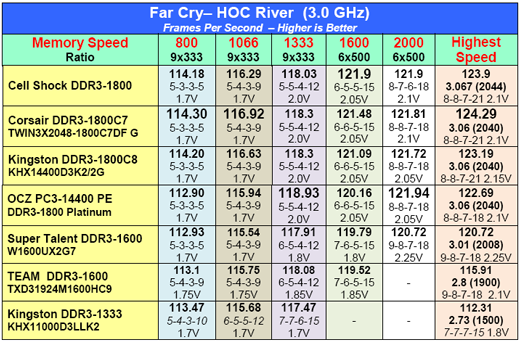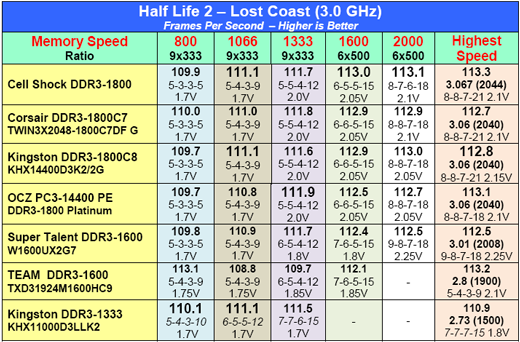Cell Shock, Corsair, and Kingston Introduce Ultra Speed DDR3
by Wesley Fink on October 11, 2007 10:00 PM EST- Posted in
- Memory
Gaming Performance
Three DX9 games representing different gaming engines are used to test the performance of the Kingston DDR3-1800C8, Corsair DDR3-1800 C7, and Cell Shock DDR3-1800 in real-world gaming. There are certainly more recent gaming titles available, but they are also DX9 and still similar in benchmarking demands as the games tested here. We will update games in the memory test suite as soon as a selection of DX10 games with reliable benchmarks is available. At that time the memory test OS will also be moved to Vista.
The Far Cry - River demo was run for 3 loops and results in FPS were averaged over the 3 runs.
Memories with Micron chips now top Far Cry performance at all memory speeds from DDR3-800 to DDR3-2000 and beyond.
Quake 4 and the underlying engine have always proved to be very sensitive to improvements in memory bandwidth. This is amply demonstrated in these memory tests. The performance increases in Quake 4 as DDR3 speed increases are the largest among the tested games.
Kingston, based on Elpida LL memory, performs best at the slower 800 and 1066 speeds, with OCZ and the other Z9 memory topping DDR-1333 to DDR3-2000+. With the constant CPU speed of 3.0GHz we see frame rates improve from 116 to 118 FPS at DDR3-800 5-3-3 to 130 FPS at DDR3-2000 8-8-7, an improvement of just over 12% among the DDR3 test group. We have commented many times that memory is just one small part of the performance equation, but a 12% improvement in a game frame rate merely as the result of an increase in memory speed is significant. Far Cry sees a similar increase from 112.90 at 800 to 124.3 at DDR3-2040, which is about a 10% improvement.
We include Half Life 2: Lost Coast as a representative of games that are less sensitive to improvements in memory bandwidth. Lost Coast is played through the Steam engine, where there is the constant worry, for a reviewer, that each new update of Steam will break your test benchmarks. Though the differences are very subtle and HL2 performance is most influenced by the video card used in the benchmark, there are nonetheless patterns that are exactly the same as the other two games.
The Kingston Elpida-based memory wins by a small margin at 800 and ties the Micron-based Cell Shock and Kingston DDR3-1800C8 at the DDR3-1066 speed. Other Micron based memories win the competitions at higher speeds with the Cell Shock the closest to standout performance. All of the results among the Z9 Micron kits are very close.
Some end users consider 7-7-7 timings at high DDR3 speeds a milestone with DDR3. We set those timings and pushed the each of the 3 DDR3-1800 kits as far as possible. The results are very interesting. The OCZ reached DDR3-1900 at 7-7-7 in an earlier review. The three new DDR3-1800 kits all outperformed this result, with Cell Shock reaching DDR3-1952, Kingston reaching DDR3-1960, and Corsair reaching the highest DDR3-1972 - all at 7-7-7- or 7-7-6 timings at 2.1 to 2.15V. We are very close to stable DDR3-2000 at 7-7-7 timings which will further improve DDR3 performance at the top of its speed range.
Three DX9 games representing different gaming engines are used to test the performance of the Kingston DDR3-1800C8, Corsair DDR3-1800 C7, and Cell Shock DDR3-1800 in real-world gaming. There are certainly more recent gaming titles available, but they are also DX9 and still similar in benchmarking demands as the games tested here. We will update games in the memory test suite as soon as a selection of DX10 games with reliable benchmarks is available. At that time the memory test OS will also be moved to Vista.
The Far Cry - River demo was run for 3 loops and results in FPS were averaged over the 3 runs.
 |
| Click chart to enlarge |
Memories with Micron chips now top Far Cry performance at all memory speeds from DDR3-800 to DDR3-2000 and beyond.
Quake 4 and the underlying engine have always proved to be very sensitive to improvements in memory bandwidth. This is amply demonstrated in these memory tests. The performance increases in Quake 4 as DDR3 speed increases are the largest among the tested games.
 |
| Click chart to enlarge |
Kingston, based on Elpida LL memory, performs best at the slower 800 and 1066 speeds, with OCZ and the other Z9 memory topping DDR-1333 to DDR3-2000+. With the constant CPU speed of 3.0GHz we see frame rates improve from 116 to 118 FPS at DDR3-800 5-3-3 to 130 FPS at DDR3-2000 8-8-7, an improvement of just over 12% among the DDR3 test group. We have commented many times that memory is just one small part of the performance equation, but a 12% improvement in a game frame rate merely as the result of an increase in memory speed is significant. Far Cry sees a similar increase from 112.90 at 800 to 124.3 at DDR3-2040, which is about a 10% improvement.
 |
| Click chart to enlarge |
We include Half Life 2: Lost Coast as a representative of games that are less sensitive to improvements in memory bandwidth. Lost Coast is played through the Steam engine, where there is the constant worry, for a reviewer, that each new update of Steam will break your test benchmarks. Though the differences are very subtle and HL2 performance is most influenced by the video card used in the benchmark, there are nonetheless patterns that are exactly the same as the other two games.
The Kingston Elpida-based memory wins by a small margin at 800 and ties the Micron-based Cell Shock and Kingston DDR3-1800C8 at the DDR3-1066 speed. Other Micron based memories win the competitions at higher speeds with the Cell Shock the closest to standout performance. All of the results among the Z9 Micron kits are very close.
Some end users consider 7-7-7 timings at high DDR3 speeds a milestone with DDR3. We set those timings and pushed the each of the 3 DDR3-1800 kits as far as possible. The results are very interesting. The OCZ reached DDR3-1900 at 7-7-7 in an earlier review. The three new DDR3-1800 kits all outperformed this result, with Cell Shock reaching DDR3-1952, Kingston reaching DDR3-1960, and Corsair reaching the highest DDR3-1972 - all at 7-7-7- or 7-7-6 timings at 2.1 to 2.15V. We are very close to stable DDR3-2000 at 7-7-7 timings which will further improve DDR3 performance at the top of its speed range.










12 Comments
View All Comments
Wesley Fink - Friday, October 12, 2007 - link
At the top of the pricing info is the name of the item being priced. In this case the engine is likely picking up Compact Flash prices at camera companies in the same memory size. The larger concern is that the pricing engine does not recognize Cell Shock right now in the pointer. Work is being done to expand the database.The Price Engine often does not pick up new items just introduced, but it is dynamic. If you look back in a few weeks the pricing info will be revised even though the pointer is the same and it will likely find the original described product.
yyrkoon - Friday, October 12, 2007 - link
And what prices are youtalking about exactly ? That is definately not DDR3 memory pricing . . .